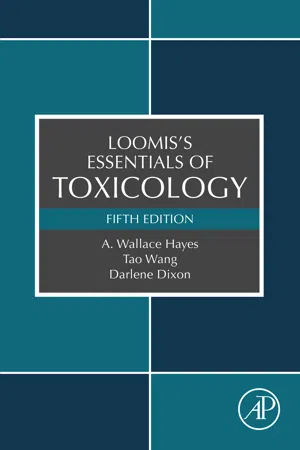
- 272 pages
- English
- ePUB (mobile friendly)
- Available on iOS & Android
Loomis's Essentials of Toxicology
About this book
Loomis's Essentials of Toxicology, Fifth Edition, provides the information on the harmful biologic effects associated with exposures to chemicals of all types. The scope of this book includes a discussion of the major types of chemicals involved, their general properties and detrimental biologic effects, the methods used to demonstrate these effects, the basis for clinical diagnosis, and therapy for the harmful effects of chemicals on humans. Individual examples are used to demonstrate the principle discussed. This reference volume will be an invaluable resource for both toxicologists and graduate and advanced undergraduate students in toxicology and public health.- Provides a revised and updated edition of one of the "gold" works in the field- Includes both principles and methods- Requires minimal background in chemistry and biology- Expanded Information Sources in Toxicology
Frequently asked questions
- Essential is ideal for learners and professionals who enjoy exploring a wide range of subjects. Access the Essential Library with 800,000+ trusted titles and best-sellers across business, personal growth, and the humanities. Includes unlimited reading time and Standard Read Aloud voice.
- Complete: Perfect for advanced learners and researchers needing full, unrestricted access. Unlock 1.4M+ books across hundreds of subjects, including academic and specialized titles. The Complete Plan also includes advanced features like Premium Read Aloud and Research Assistant.
Please note we cannot support devices running on iOS 13 and Android 7 or earlier. Learn more about using the app.
Information
Introduction, scope, and principles
Abstract
Keywords
Table of contents
- Cover image
- Title page
- Table of Contents
- Copyright
- Dedication
- Preface
- Chapter 1: Introduction, scope, and principles
- Chapter 2: Dose and dose-response relationships in toxicology
- Chapter 3: Biologic factors that influence toxicity
- Chapter 4: Chemical factors that influence toxicity
- Chapter 5: Influence of route of administration on systemic toxicity
- Chapter 6: Genetic factors that influence toxicity
- Chapter 7: Classification of harmful effects of chemicals
- Chapter 8: Toxic effects of chemicals
- Chapter 9: Abnormal response to chemicals
- Chapter 10: The basis of selective toxicity
- Chapter 11: The basis of antidotal therapy
- Chapter 12: Principles of biological tests for toxicity
- Chapter 13: Toxicologic testing methods
- Chapter 14: Clinical toxicology
- Chapter 15: Information sources in toxicology
- Index